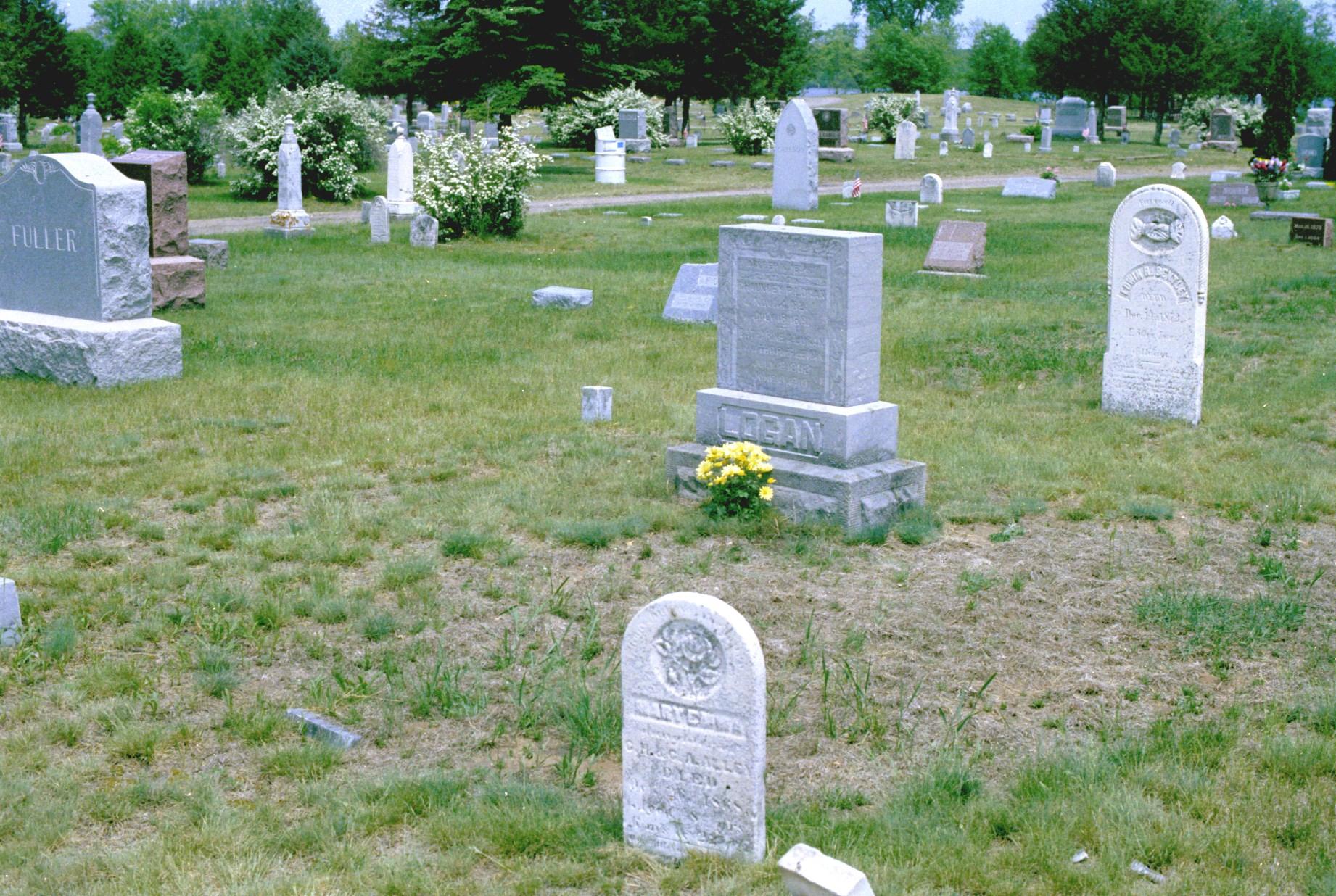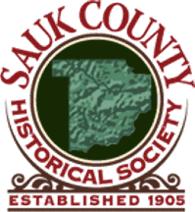Chauncey P. Logan
The founder and namesake of Loganville
1821—1881

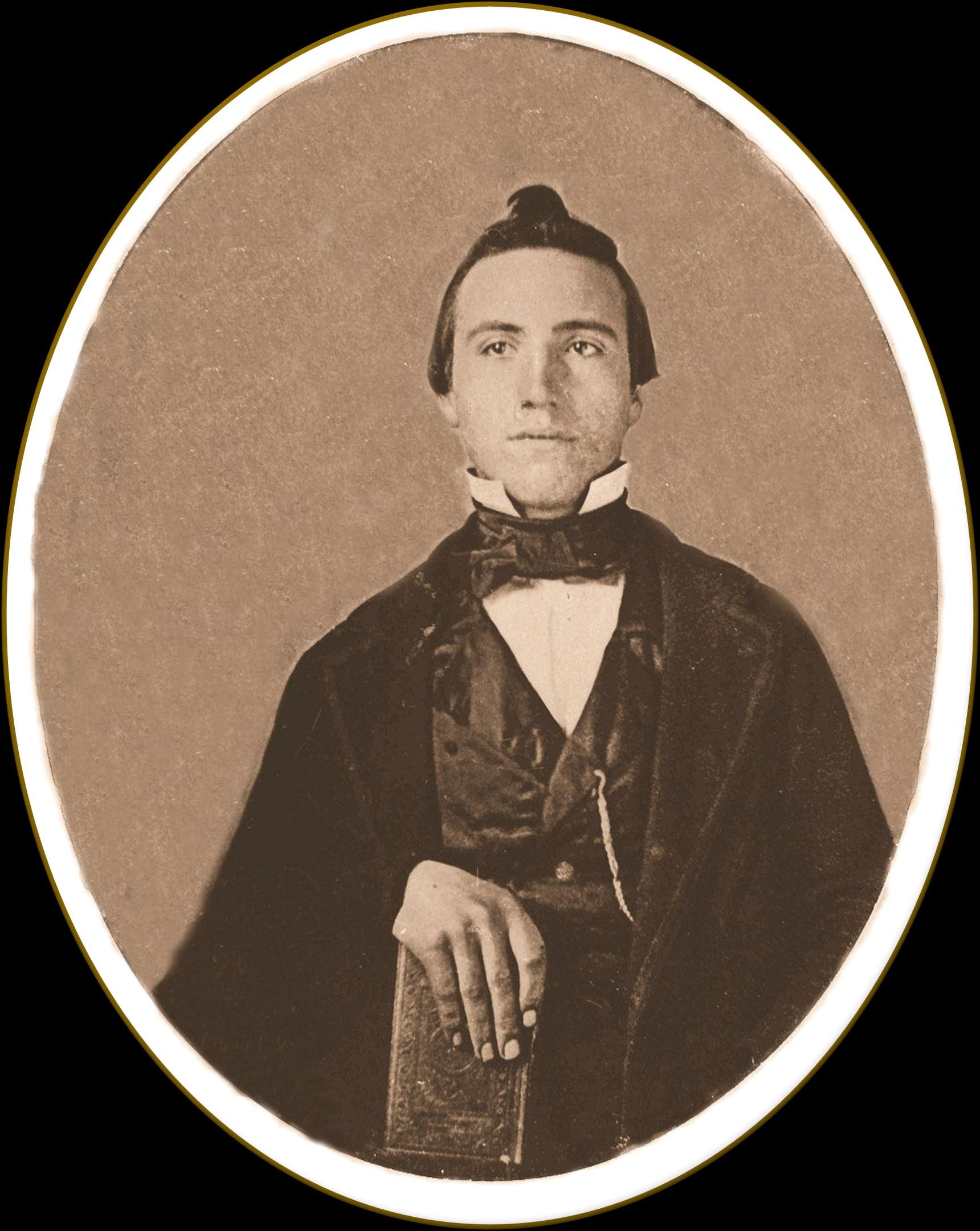









The founder and namesake of Loganville, Sauk County, Wisconsin
Researched and compiled by William C. Schuette
Copyright 2024
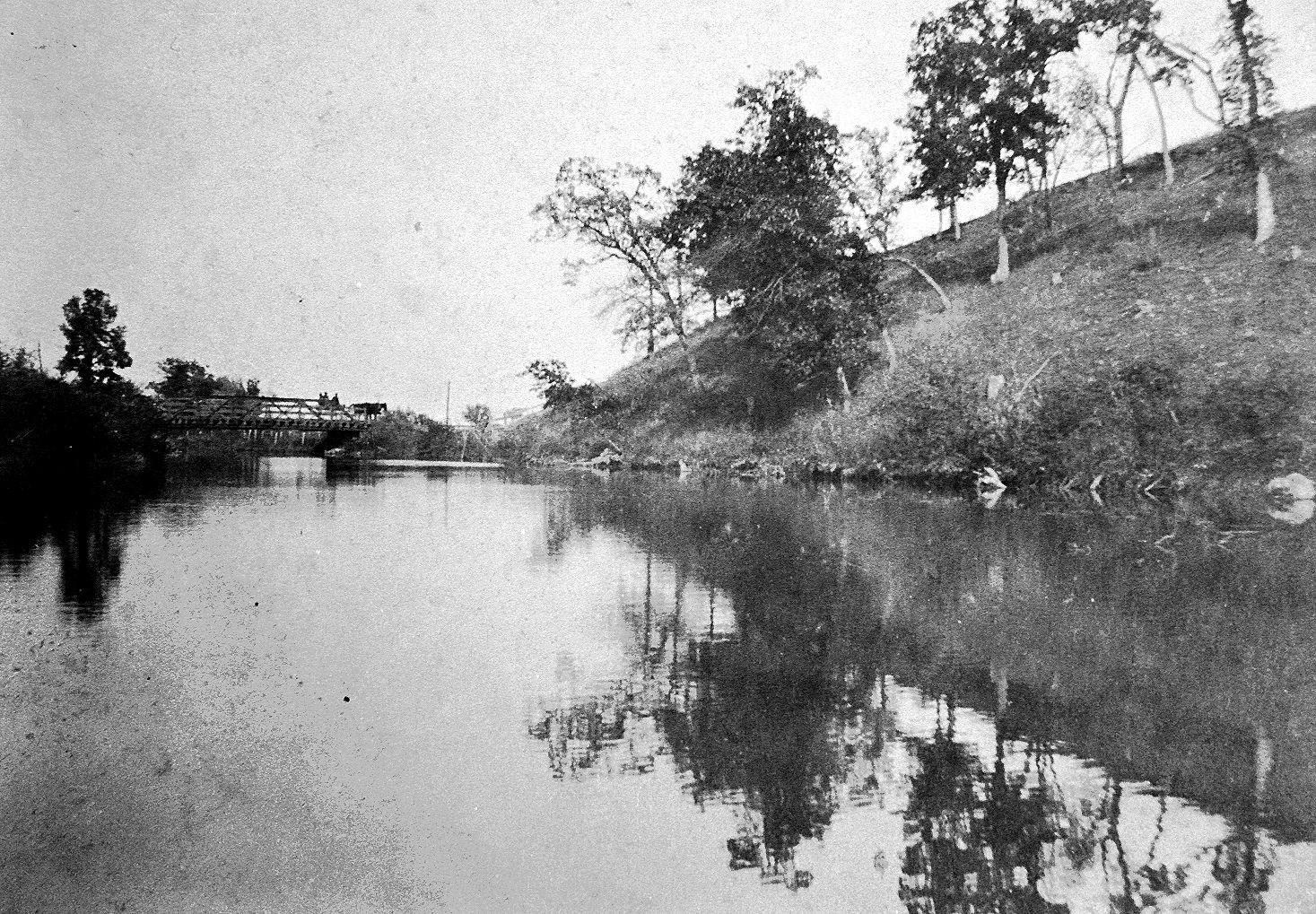

The bridge in the background, is located on what is highway 154 today. The mill pond, pictured here around 1900, was formed when Narrows Creek was dammed to provide power to run a sawmill and flour mill. Water under the bridge was about 12 feet deep, and was a popular swimming hole. When the dam went out for the last time in the nineteen teens, the hill on the right was pushed in to fill the mud hole.
Chauncey P. Logan came into the territory in the winter of 1853-1854 and settled at the foot of a hill along Narrows Creek at the place we now call Loganville. The Logans, with their son, Albert E., came originally from New York and settled in Dodge County, Wisconsin. Logan obtained the land in Westfield from his wife’s uncle, Mr. Brown. Brown told Logan: “I’ll give you a quarter section of land in Sauk County for your 40 acres here in Dodge County, but I will deed it to your wife and Mrs. R. B. Balcombe (her sister) to induce Mr. Balcombe to come too.” So, both families packed up their belongings and came to Sauk County that winter. They stayed with the Segents while they constructed a one-room, log house in the southeast corner of section eight in February of 1854. The following spring they decided that each family needed more privacy and space so they added a second room to the cabin. That was the first house built in the village of Loganville.
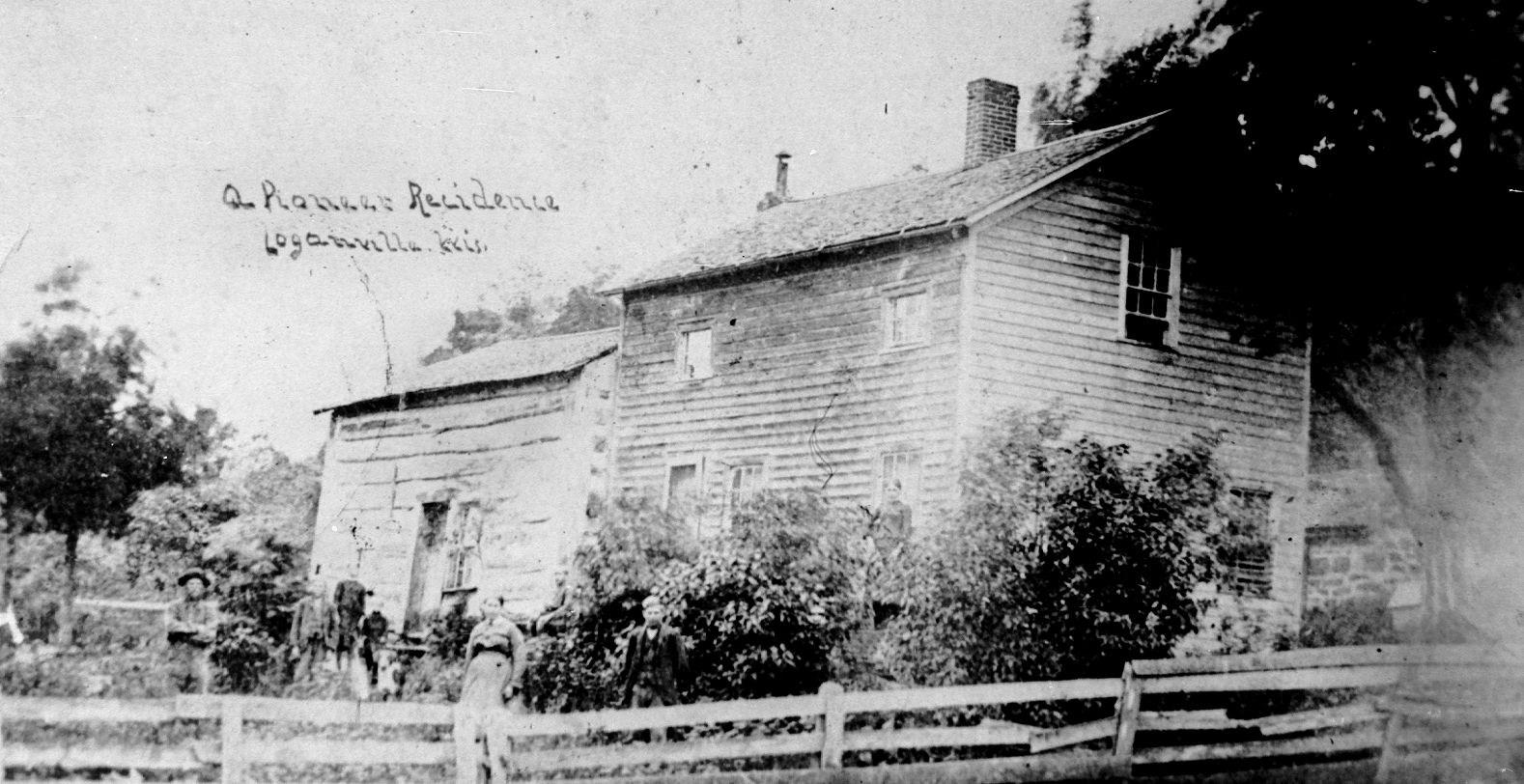

“A Pioneer Residence, Loganville, Wis.” Whose residence this might have been, is unknown. However, it may be similar to many log cabins whose residents outgrew them, and additions were added to accommodate the growing families, or relatives, as noted in the paragraph above.
The Balcombes and Logans resided together for several years. The house was later turned into a barn by Judge Niemann, a subsequent owner. The site of this first cabin is owned by Mrs. Reuben Black today (1980).
During the summer of 1854, Stephen Kinsley and Chauncey P. Logan joined in partnership and began the task of plotting the village with the help of S. J. Brown, a surveyor. See the following page. The village was first called Westfield, after Kinsley’s home township back in New York State. It was only later that the village took the name of Loganville. When the village applied for a post office, there was already a Westfield in the state, so that’s when the village’s name was officially changed to Loganville.


A survey was conducted of the site of the new village of Westfield by S.J. Brown on 20 July 1855. The plat was recorded at the Sauk County Courthouse in Baraboo on 28 August 1855. Chauncey Logan, Frances Logan, his wife, and Stephen N. Kinsley witnessed the event. The village did not take the name Loganville until later.
The plat of the village was completed on July 20, l855, and was recorded with the register of deeds at the Sauk County Courthouse in Baraboo on August 28, l855. Chauncey Logan, Frances A. Logan, his wife, and Stephen Kinsley witnessed the transaction. See previous page.
The Township of Westfield was also organized in 1854, with J. K. Thompson as Chairman, Martin Davey and Henry Nippert as Supervisors, William Baird as Clerk, R. B. Balcom as Treasurer, Chauncey P. Logan as Justice of the Peace, Lyman Twist as Assessor, N. H. Briggs (grandfather of Clare Briggs a noted cartoonist in the early 1900s) as Superintendent of Schools and R. T. Root as Constable.
On September 24, l854, Kinsley and Logan purchased the water rights on the north side of town for $100 from James Davis and they commenced building a dam across a narrow neck in the creek, thereby providing a good head of water to power the sawmill that they completed in the spring of 1855. They began turning out sawed lumber for the new homes that were going up all over the area. The mill was in use until around 1877.


This dam on Narrow’s Creek was built around 1900, and provided water power for the grist mill which was located on the north side of the village. The creek’s water power was in use up until the late1900s.
Mr. Logan dropped by the offices of the Baraboo Republic in May of 1856 and informed the editor of the progress that was being made in the growing village of Loganville. “We learn by C. P. Logan, Esq., one of the proprietors of the village plat in Westfield, that improvements are continually being made up Narrows Creek Valley, and that the village of Westfield is making a good progress, that preparation is being made for building a grist mill, also a steam machine shop, and a chair and cabinet ware shop.
They have at this point, three stores, a public house, blacksmith shops and other mechanical establishments. There are some 20 houses and they are making a good start for a nice village. The village is situated near the center of the township. They have a good white limestone quarry within a half a mile of the village. This young village is situated nine miles southerly from Reedsburgh, 16 miles westerly from Baraboo, 18 miles northwesterly from Sauk [Prairie], 16 miles from the M. & M. Railroad, 23 miles from Richland City.”
They have at this point, three stores, a public house, blacksmith shops and other mechanical establishments. There are some 20 houses and they are making a good start for a nice village. The village is situated near the center of the township. They have a good white limestone quarry within a half a mile of the village. This young village is situated nine miles southerly from Reedsburgh, 16 miles westerly from Baraboo, 18 miles northwesterly from Sauk [Prairie], 16 miles from the M. & M. Railroad, 23 miles from Richland City.”
Loganville - the cross roads of the West! A rather strong statement indeed, but that is how Chauncey Logan described the little village to the family of David B. Hulburt when he met them as they arrived in Milwaukee in July of l857. Mr. Hulburt, in a speech given to the Old Settlers meeting on July 2l, 1882, recounts his experiences in coming to Loganville:
“The first thing that especially attracted my attention after landing in Milwaukee as being different from anything I had witnessed in the Eastern states, was the anxiety everywhere manifested by those who had preceded us, to induce new comers to settle in their locality. This was especially true of those who aspired to be the founders of a new town or village. We were collared by several of those aspirants soon after landing from the boat. The amount of argument, facts and figures that each would use in favor of his own locality seemed almost exhaustless. This, to my mind, accounted for the wonderful and miraculous stories of the beauties and advantages of the West that found their way back to the East from those who had preceded us. It was an exemplification of the adage, ‘misery loves company.’
“Loganville, our present home, was no exception to this general rule. I do not wish to speak disrespectfully of the founder of that village, but he collared us, and explained that it was but little over two hundred miles from Chicago still less from Milwaukee; the Mississippi on the west furnished ample facilities for steamboat navigation; it was on a direct line between the lead mines of the South (then an important interest in the state); and the best pine forests in the North, to say nothing of the copper mines of Lake Superior. It was next to impossible to go from one important point to another in the state without striking Loganville on the route.
All lines crossed each other there like the diagonals and bisecting lines of a parallelogram or great hollow square. It was conceded that Madison, Portage and some other places might become competing points, but they were too remote to seriously affect our retail trade. If ever a shadow came upon his face, it would be when someone would ask how far it was from Shelden’s Mill or Sheldonville, as it was sometimes called, which latter village had at that time another small sawmill, about two miles farther down the same stream.
We, of course, settled at Loganville. Not that we took in all that its founder hoped. We were not looking for cities. We had left many of them behind us; had passed many while on our way here. We were like the rest of you, seeking a home we could call our own. Our pioneer experience in most respects was not unlike that of all pioneers in a new country.
“But we have learned to love the West, Western ways and Western people. We are satisfied with Sauk County. She is not only rich in that which pertains to material wealth, but she is rich in picturesque and variegated scenery. She has within her border’s scenery that, were it in Switzerland, would be visited and dilated upon by travelers and pleasure-seekers from every part of the civilized globe. We love the old pioneer spirit. The old pioneer spirit was to strike for the open sea, while that of modern times is to gather in shoals near the shore, or, to speak more accurately, the old pioneer spirit was to strike for open, unoccupied fields and build for themselves. That of modern times seems to be to gather along our railroad lines.”
The Baraboo Republic was, in 1859, running a series of articles which described the various communities in Sauk County. That May, it was Loganville’s turn. Or was the village called Westfield at that time? There seemed to be a bit of confusion about the name in those early days.
“Narrow’s Creek Valley is quite equally divided between timber, marsh and prairie. The stream itself has a rapid current, and is already four times dammed with a sawmill upon each dam. Upon this creek is situated the village of Westfield, well located for a business point, and having already a sawmill and two stores with a flour mill nearly completed. Narrow’s Creek has a large basin of county for the size of the creek, containing from 45 to 50 square miles, and is a rich valley of land. Logansville, or as it is now called, should do its business, but it goes mostly to Reedsburg.”
As in the above article, Loganville was sometimes spelled with an “s”.
The Reedsburg Free Press began publishing a weekly newspaper in the year 1860. It will be from that chronicle that we shall now draw much of our information about the events and happenings in the Loganville community. Some of the articles are funny and some are sad, but each one gives us a little more insight into the lives and times of those early settlers. The writers of the Loganville items usually did not sign their articles, much to the chagrin of the Press editor, but they would often use their initials or a nickname perhaps to prevent reprisals for writing something about a fellow villager that might have lacked complete accuracy. We shall begin our Free Press coverage in 1860 with the Independence Day celebration as noted in the July 16th edition:
“The citizens of Westfield and vicinity commemorated the 84th anniversary of our national independence by holding a union celebration, got up on the genuine Pick Ni’k principle, which was largely patronized by the people of the town and surrounding country. At half past eleven A. M. the assembly were piloted to the speaker’s stand (a tastefully designed bowery erected for the occasion). The audience was then called to order by William Palmer Esq., President of the Day, and after an eloquent and feeling prayer by the Chaplain, Rev. John Seamans, and the able reading of the Declaration of Independence by D. B. Hulbert, Esq., and a couple of appropriate national airs by the Westfield Glee Club, Joseph Mackey, Esq., of Reedsburg delivered a highly edifying and eloquent oration which was well adapted to the times and the occasion, which not only commanded the undivided attention but met the unqualified approbation of all present.
A procession headed by Braley & Rowley’s Martial Band was then formed under the direction of D. B. Hulburt, Martial of the Day, assisted by Dr. S. N. Sallada and C. P. Logan. A march of about eighty rods was then ordered which brought us to the table containing refreshments. But here we hesitate, knowing that our language is not adequate to the task of doing the ladies justice by faithfully picturing the inviting scenery.
To say that it was magnificent, superb, or that we were conducted to one of the most sumptuous repasts that the eye ever beheld or palate ever welcomed, would hardly be an approximation to the view before us, of the 240 feet of table (in the dense shade of a beautiful bowery) almost groaning under its burden of pound and silver cakes, pies, tarts, pyramids and etc., of various kinds and variously decorated with ornaments, emblems and mottos, in the midst of which was the ‘Liberty Tree’, an evergreen, each of whose branches were graced with a flag, representing the state whose name and motto it bore, the whole being crowned by a banner bearing our ‘bird of liberty’ surrounded by neatly wrought letters of the motto of the United States. And finally, everything was not only tastefully arranged, but arranged to suit the taste of either the epicure or the most fastidious.
The number partaking of the refreshments was variously estimated from six to eight hundred, after which the assembled proceeded again to the speakers stand, and after listening to appropriate and well-timed speeches delivered by Rev. Mr. Bassenger, William Palmer and Prof. Dean, of Omro, with any amount of ‘toasts’interspersed with cheers and martial music, the assembly adjourned. The best feeling prevailed during the day, and each and all seemed to feel that their anticipations had been more than realized and that they had had a great time generally.”
The following year, another great Independence Day was celebrated. “The 4th of July celebration this year (1861) at Loganville was one that will never be forgotten by those who participated in it. Braley’s well known band was in attendance, enlivening the occasion as only martial music can do, and the oration, by Hon. E. G. Wheeler of Reedsburg, was a splendid effort, replete with the most devoted and unflinching Union sentiments. Asumptuous repast was served up by C. P. Logan, Esq., and all enjoyed themselves hugely on the occasion. As elsewhere, all [political] party feeling was dropped.”
The previous excerpts are from “Loganville, Our Heritage, A History of Loganville, Wisconsin” 1980, by William C. Schuette and David Burmester.
There is no further mention of the Logans in the Reedsburg newspapers after July 4, 1861. It is noted in the January 1, 1861, Reedsburg Free Press, that Chauncey Logan had resigned as post master in Loganville, so he may have left the area some time in mid 1861.
Chauncey Logan purchased some land in Juneau County on June 29, 1865.
He was called for Jury Duty on May 6, 1869, in Juneau County, WI.
In the 1850 & 1860 Census’, he was recorded as living in Beaver Dam, Dodge County, Wisconsin.
In the 1870 Census, he was recorded as living in Germantown, Juneau County, Wisconsin. His son, Albert, 25, also lived there. Both were farm laborers.


Back in 1981 when the history of Loganville was published, we had not been able to put a face to the name of Chauncey P. Logan, the founder of the village of Loganville. After eight years of research and two years of putting the book together, we had not located a photograph of our founder.
During the summer of 1980, we were successful in finding Logan’s final resting place in the Bayview Cemetery at Necedah, but the search for living relatives eluded us.
The search for a photograph began in August of 1981. Since we knew that Logan’s son, Albert, had lived in Monroe County, we had the death records there checked for the Logan name. Albert’s name was there and so were the names of two of his sons, William and Herbert. We then knew their dates of death so we obtained microfilms of the newspapers from that era for those dates.
William Logan had died in 1950, Herbert, in 1962. Obituaries are wonderful sources for the names of surviving family members. Herbert Logan’s obituary listed two nephews, Herbert and Harold Guthrie, who were sons of William Guthrie. We next obtained a copy of the Monroe County telephone directory, hoping that they might still be living. There was indeed a Herb Guthrie listed from Tomah. A letter of inquiry brought a response which indicated that the Guthries were related to the Logans, but that they had no information about our founding father. In the letter, however, the Guthries mentioned that Chauncey’s only surviving granddaughter had died in January of 1981, and that one of the other relatives, Mrs. Lawrence Ullrich, had her effects.
Mrs. Ullrich, of Rockford, Ill., responded to our letter, and what a response it was! On Christmas Eve, 1981, her reply arrived in a large padded envelope. The package contained four photographs, one of which was a faded tintype of Chauncey P. Logan! What a wonderful Christmas present. The other photos were of Francis Logan, Chauncey’s wife; Albert Logan, Chauncey’s son, and Albert’s wife, Mary. Mrs. Lawrence (Elaine) Ullrich is the daughter of Emilie and Harold Guthrie. Harold Guthrie is the son of Florence and William Guthrie. Florence is the daughter of Mary and Albert Logan, and Albert is the son of Chauncey and Francis Logan.
It has been calculated that this picture of Chauncey Logan based upon his clothing style was taken in the early1840s, when he was in his early to mid-20s. He arrived and settled Loganville in 1854, when he would have been around 33 years old.



This is a copy of the original photo as received from Mrs. Lawrence (Elaine) Ulrich.
Note the rosy tint on Chauncey’s cheeks. The color was painted in by the photographer.
He appears to be holding a Bible.
The chain on his vest was probably attached to a watch in his vest pocket.
He is wearing a “stock collar” around his neck. It is made stiff with a lining of woven horsehair. It opens in back and fastens with hooks and eyes, but a buckle and strap was another common fastening. The bow on the front is permanently tied.
Below is a letter from the State Historical Society of Wisconsin, Curator of Costume & Textiles, regarding the age of the photo of Chauncey Logan.



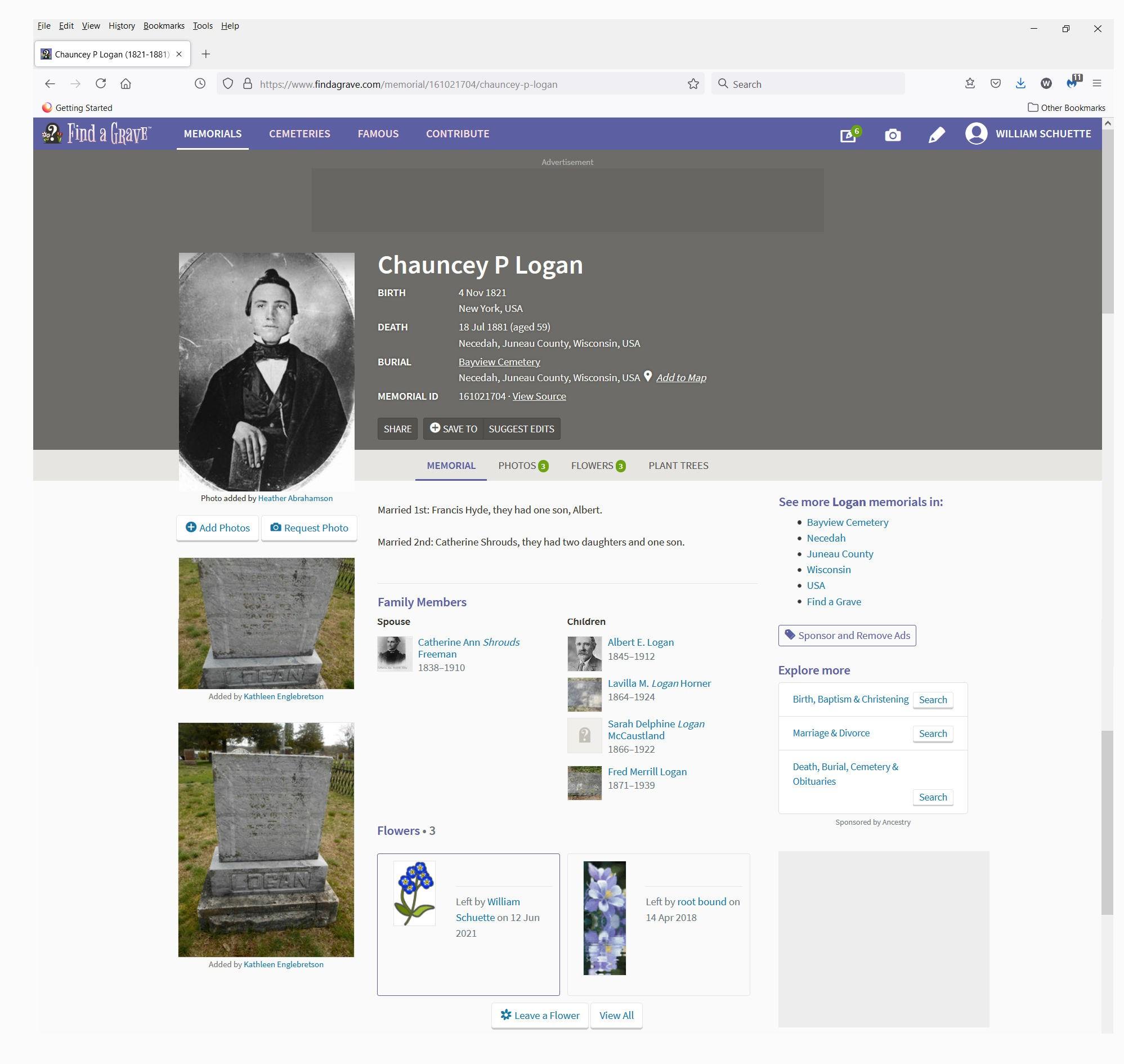






Forget me not flower
Bayview Cemetery
Necedah, Wisconsin










She is listed as a Magnetic Healer

Magnetic healing, is a method of curing diseases through the vitalizing power which one person can impart to another, or of the healing power which one by the intelligent use of his will can generate within himself. Thus for magnetic healers, medicine was merely a means (or even a purposeful ruse) to encourage positive thoughts.








The Bay station building escaped damage because it did not extend as far back as the others, but beyond it to the east was the office building of Marcuse & Remmel, occupied in the upper story by Mrs. Frances A. Logan, a faith healer. This building was very badly scorched in the rear, which portion will have to be rebuilt. The loss on the building is $1000 [$36,000 today]. The Logans managed to remove most of their valuables, but will suffer a loss of about $100 [$3,600 today].
Excerpted from the left.





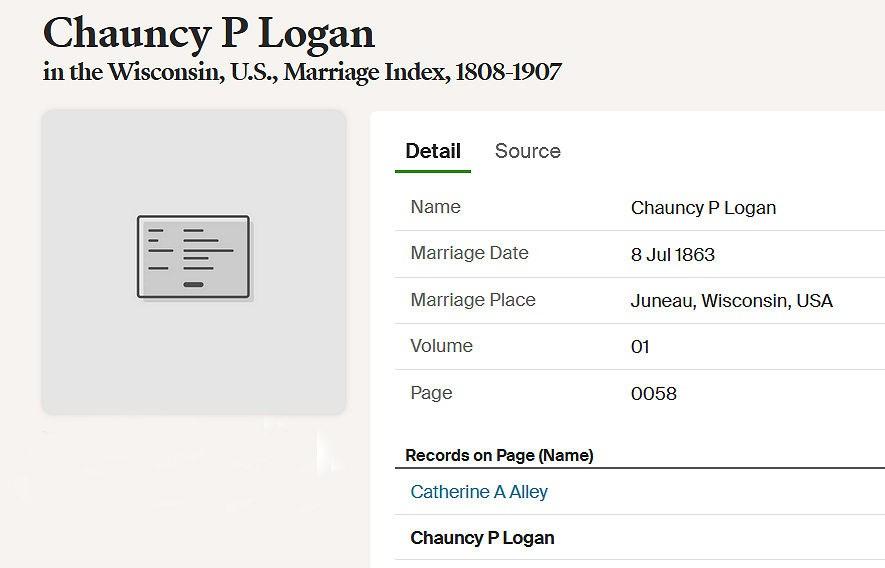



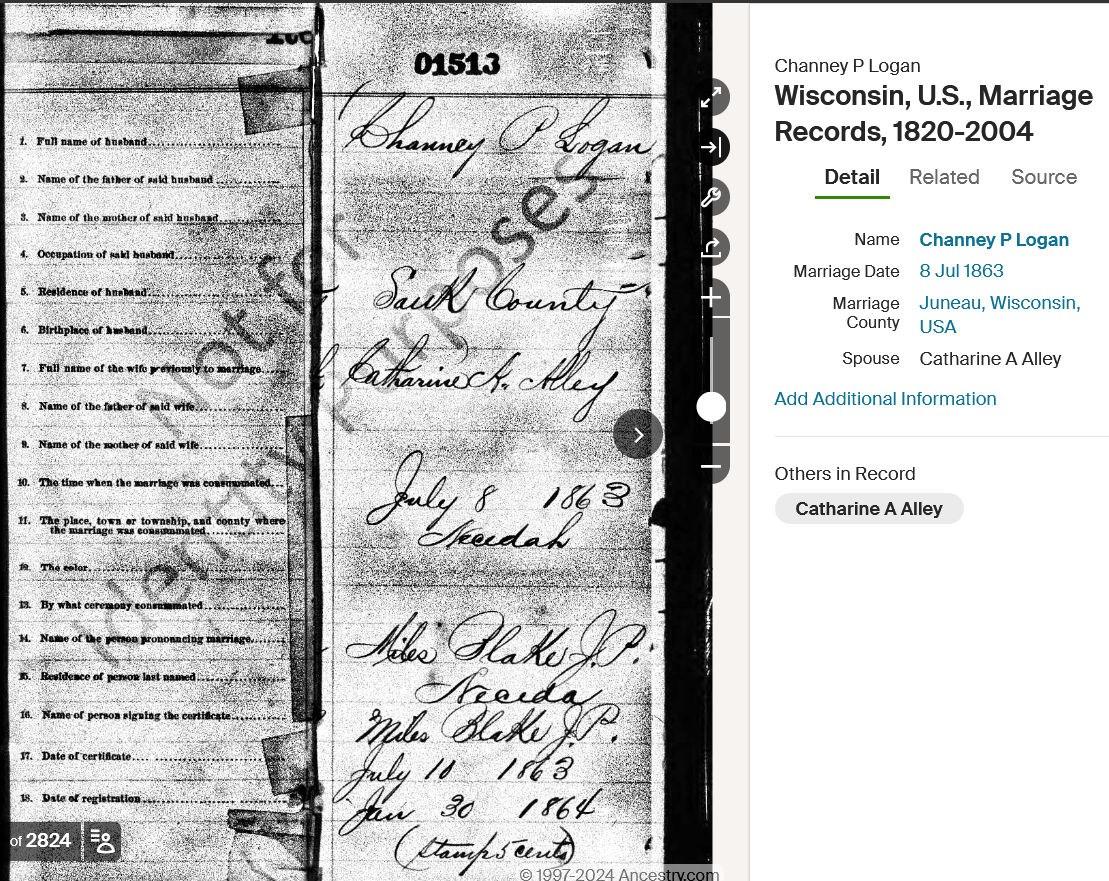










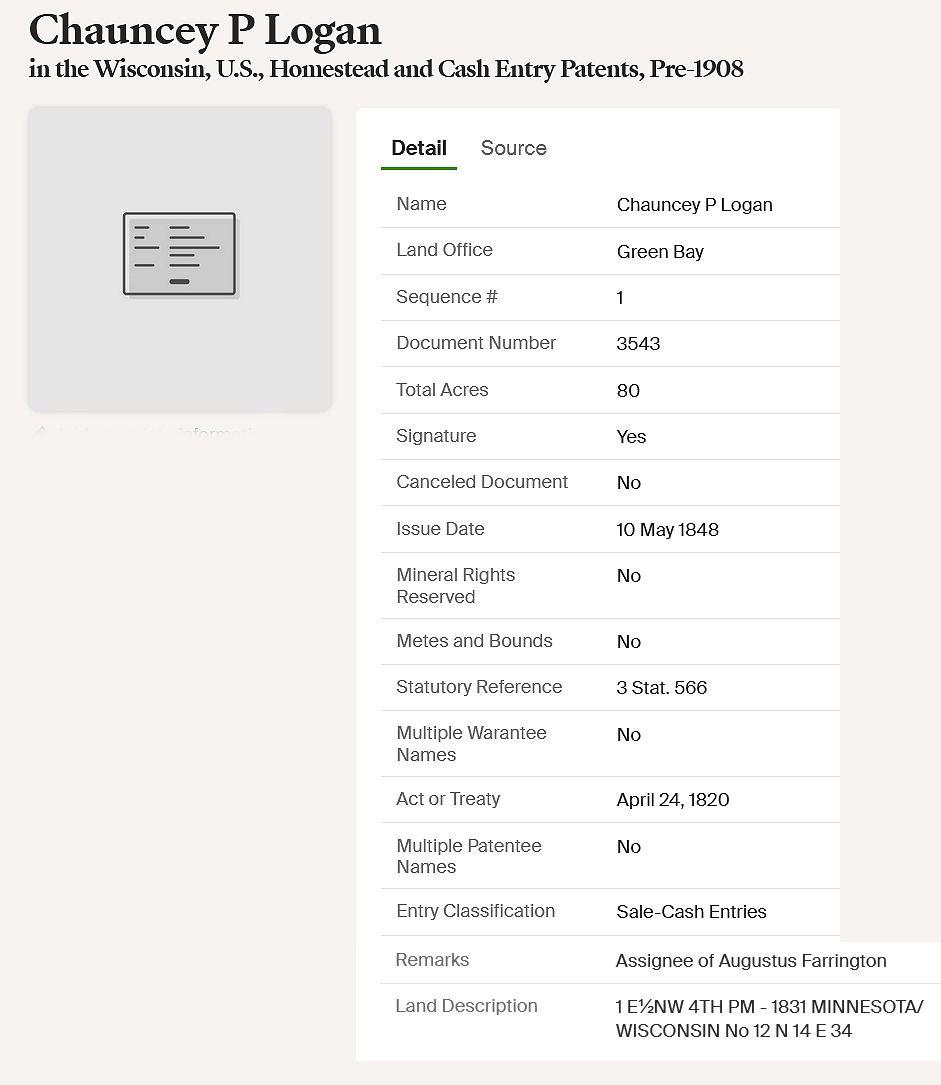

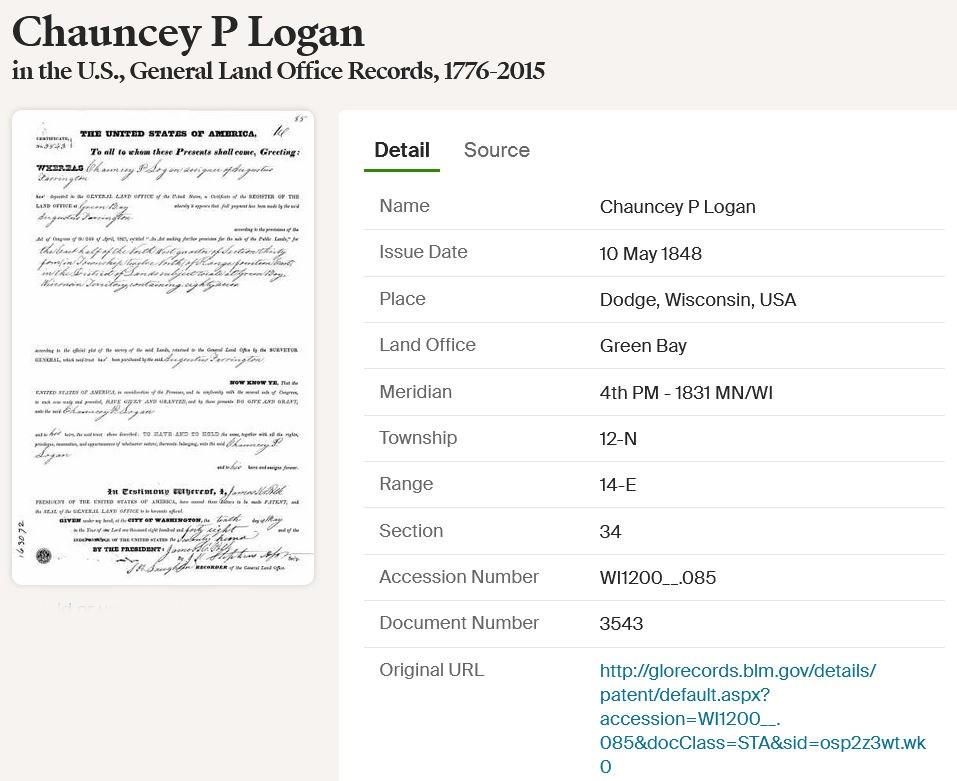




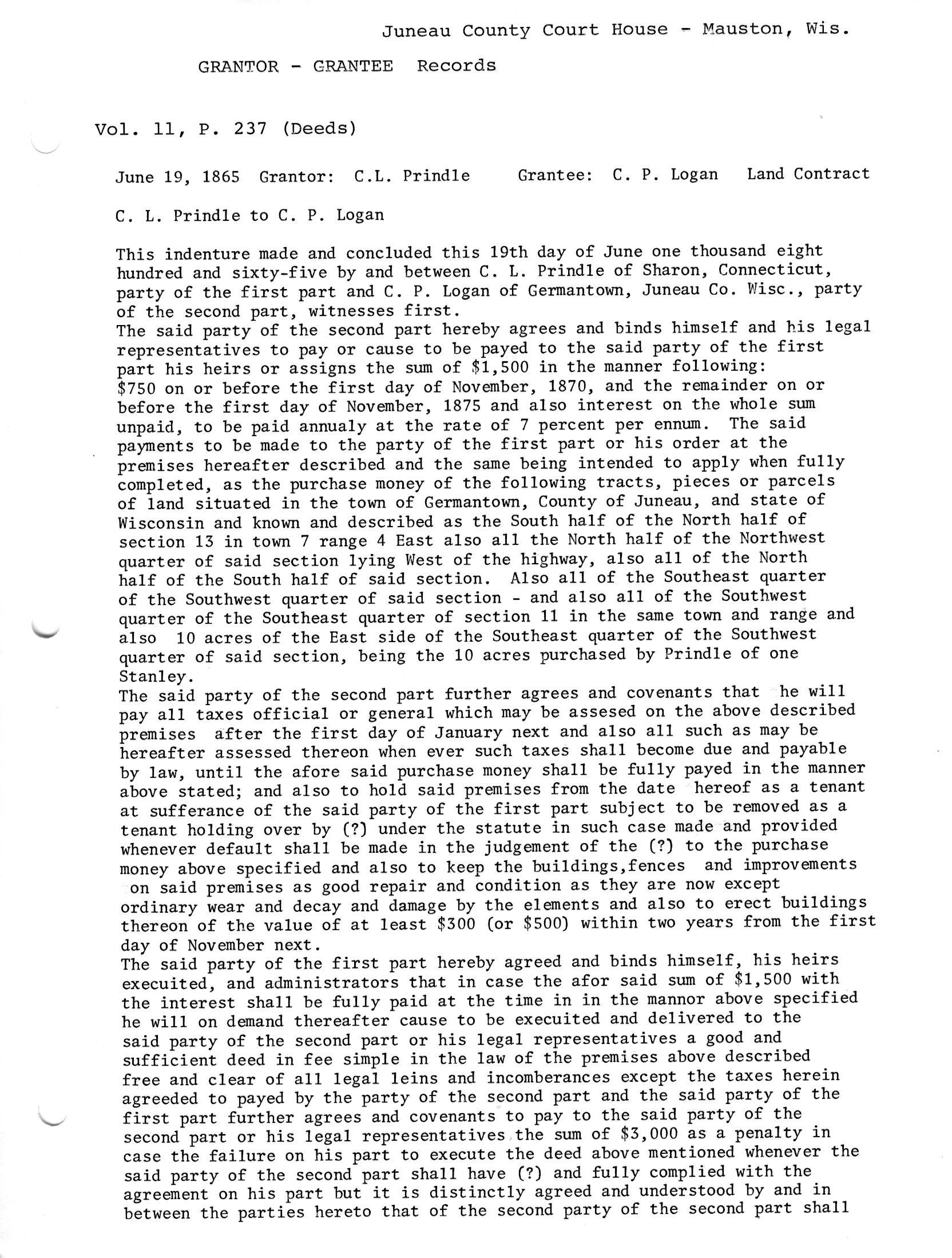
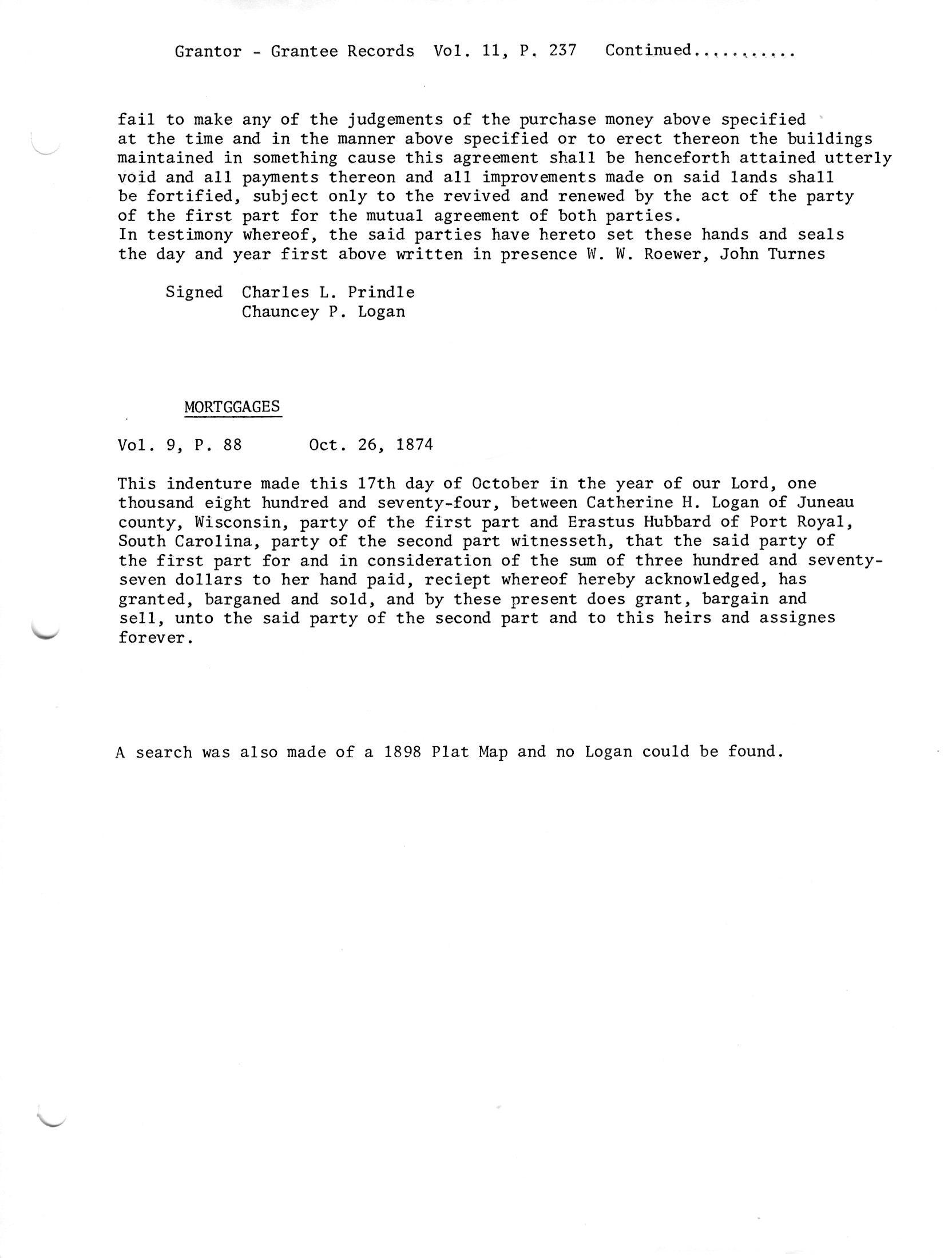
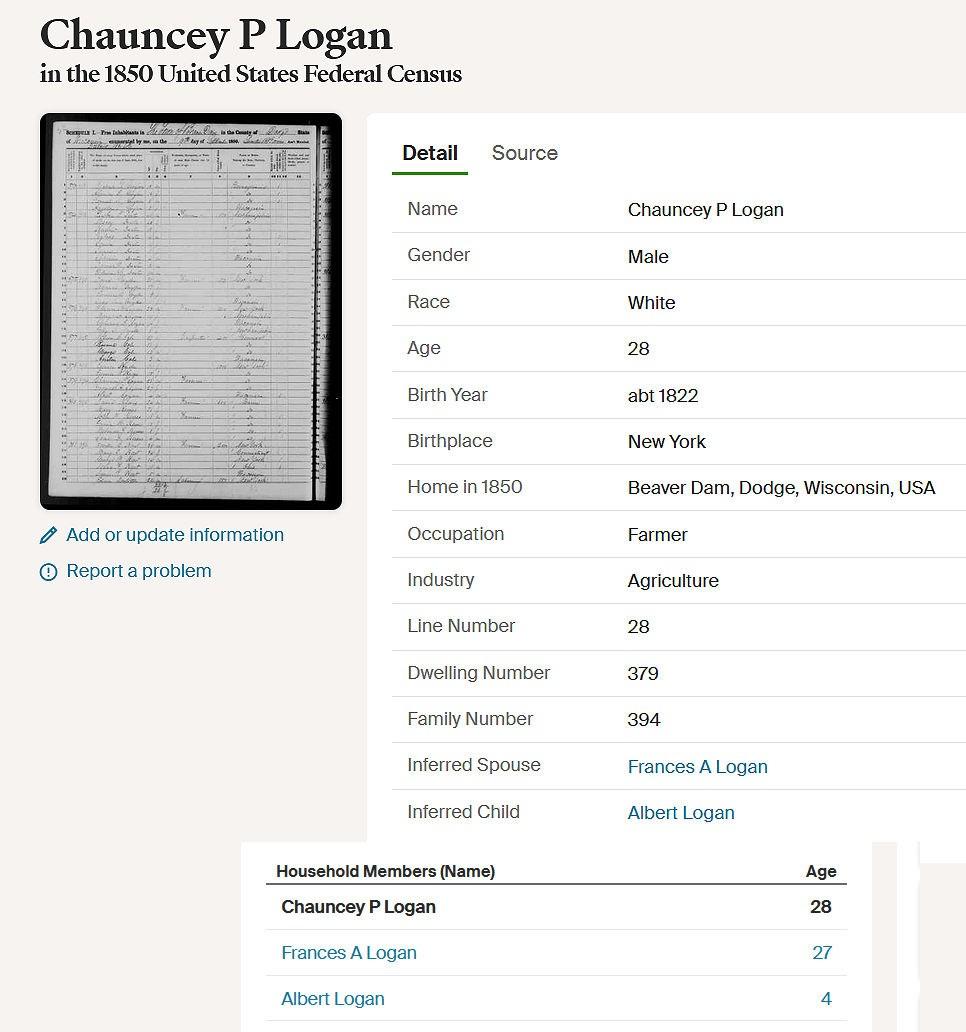

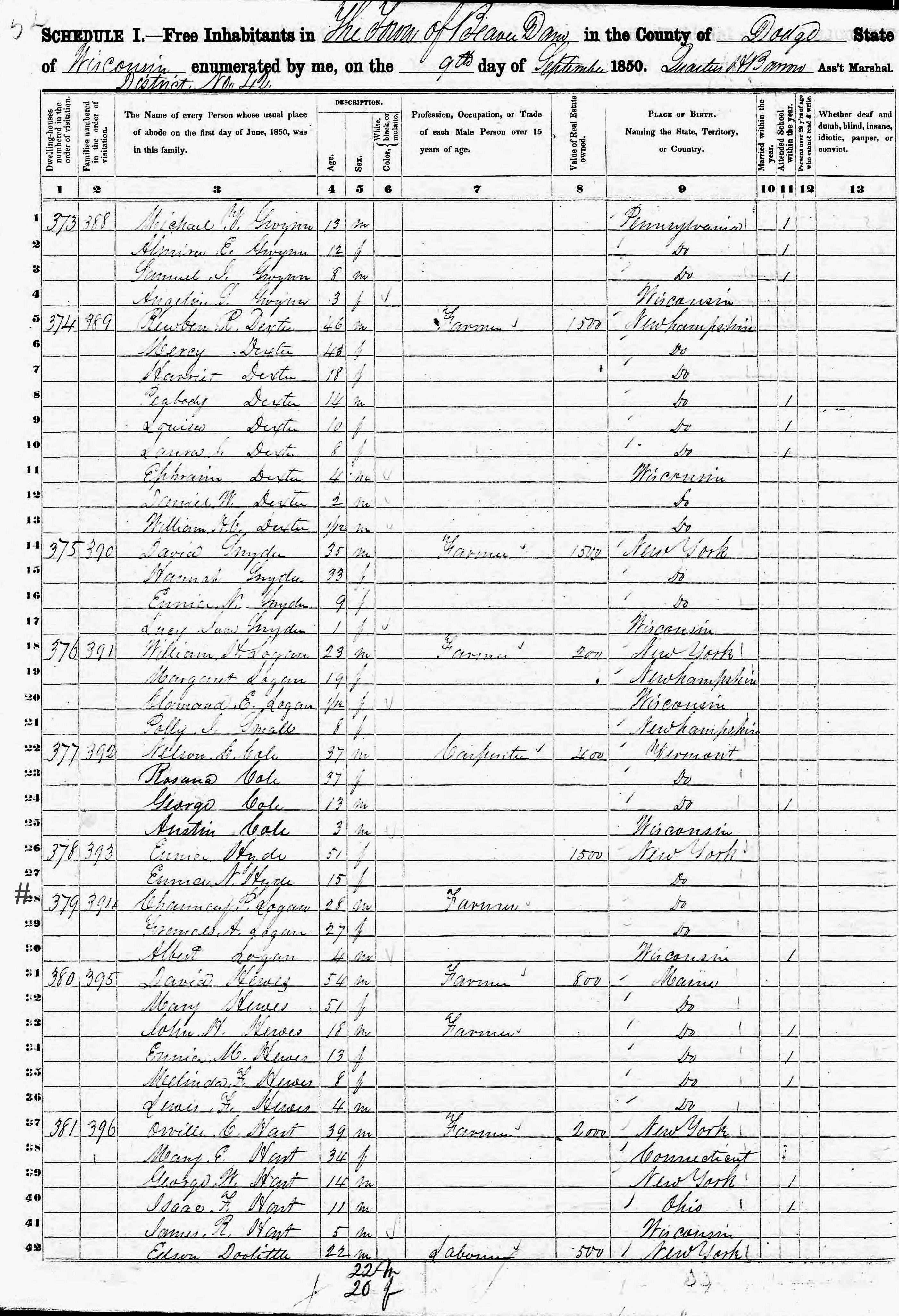



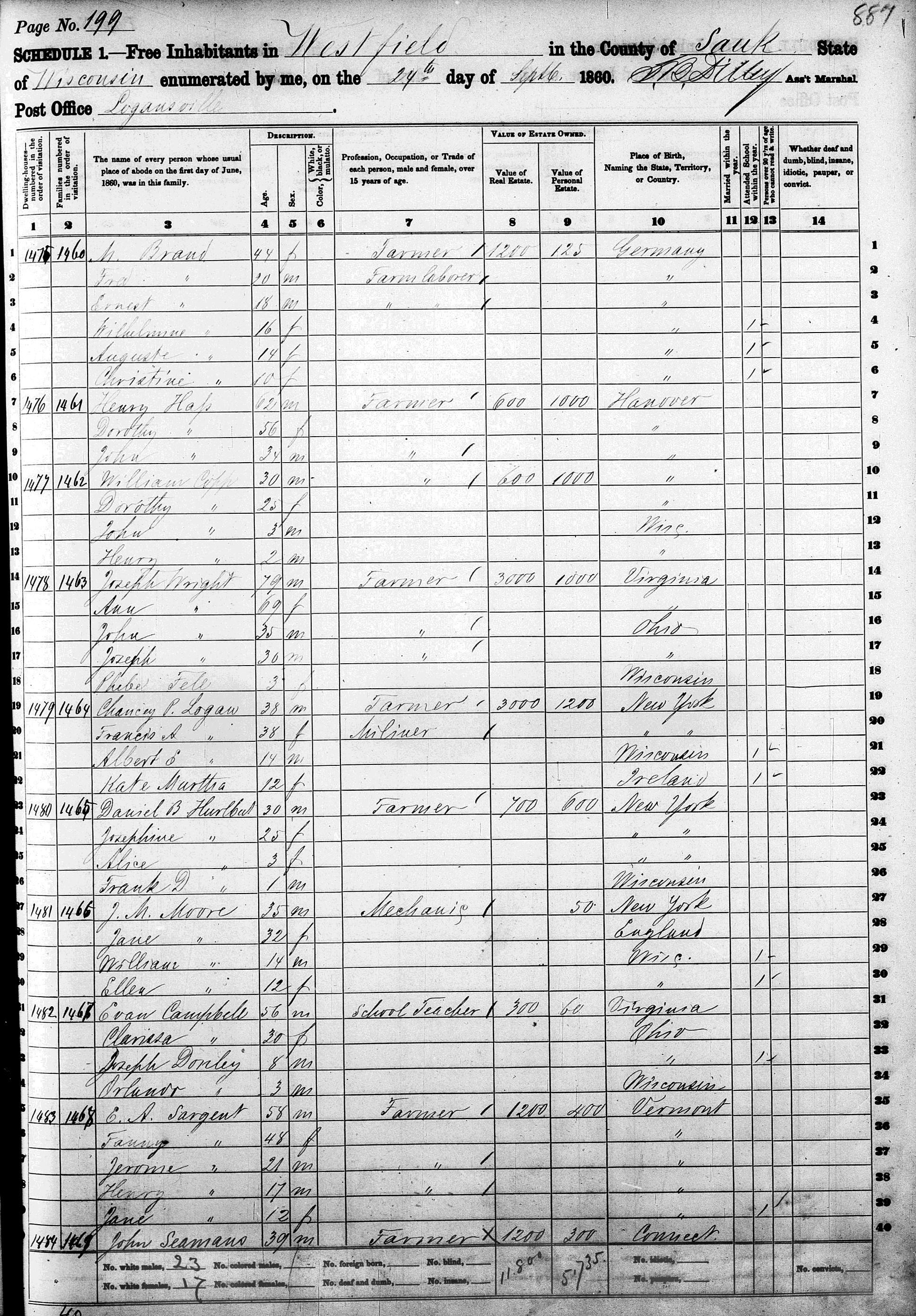





Chauncey and his family were living in Germantown because his son also lived there.




1880 Census


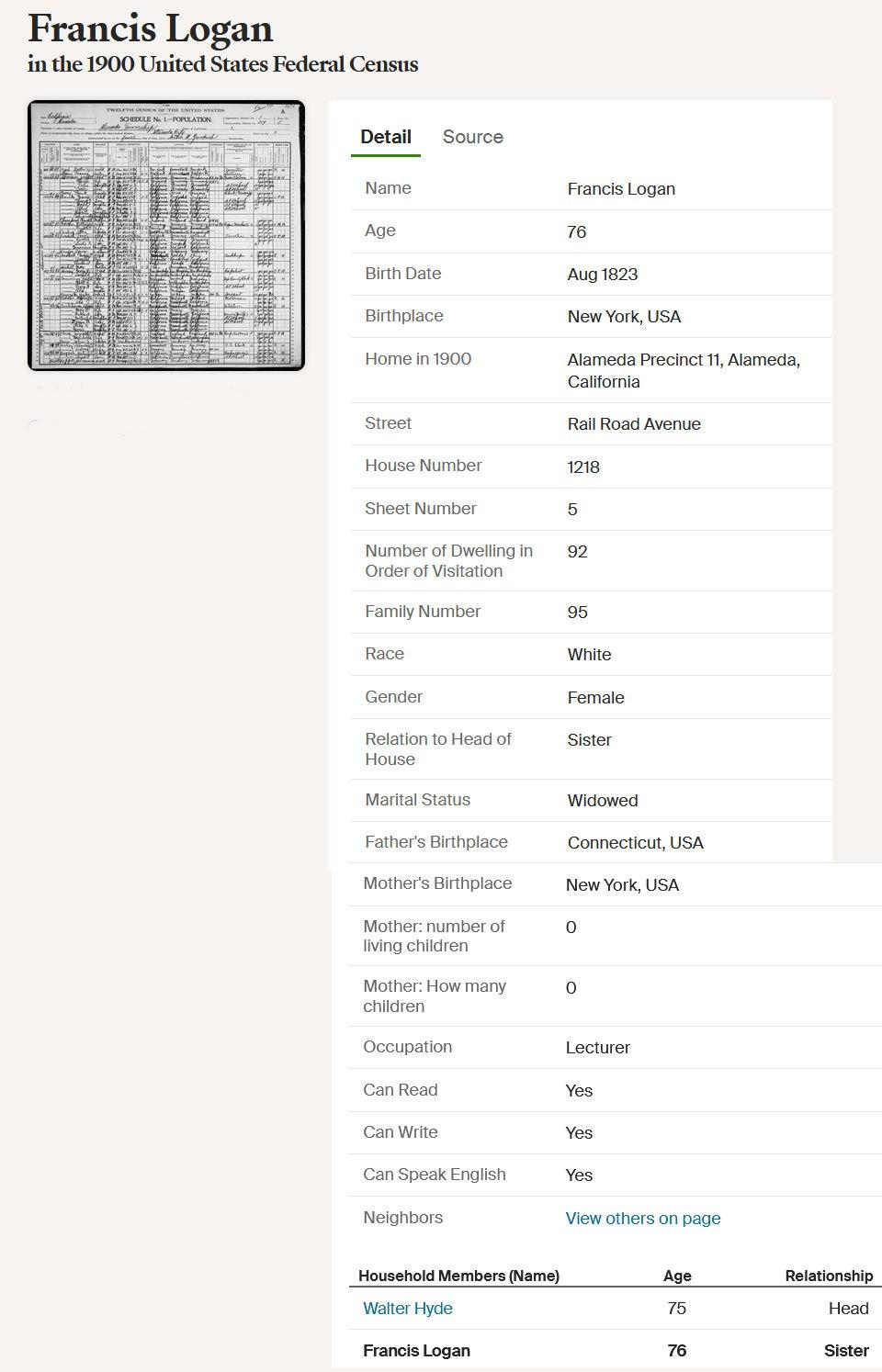



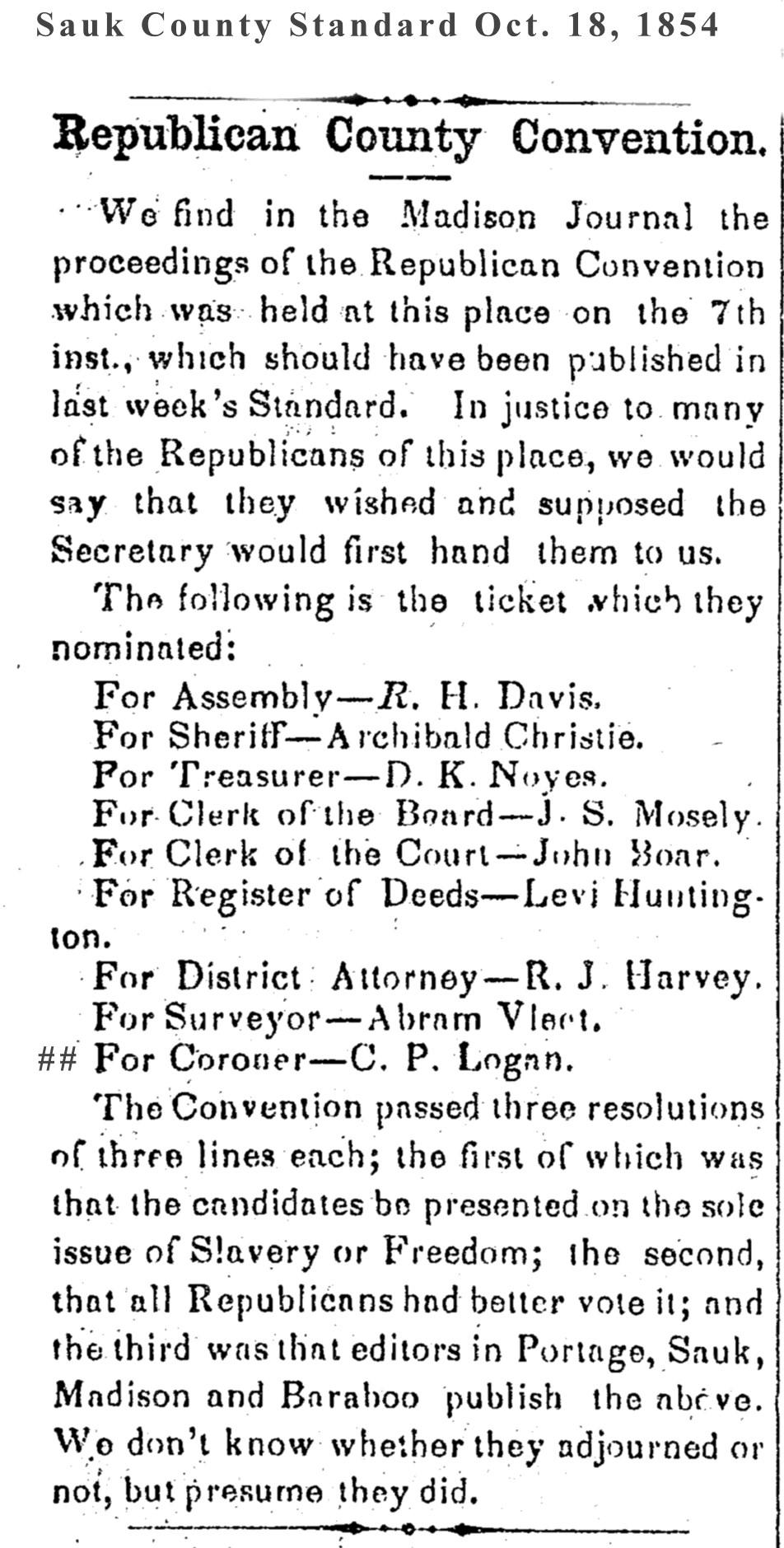

Chauncey Logan was a Democrat, based on other newspaper articles. However, he may have been the only person in the area who could-or would-take the job of corner.
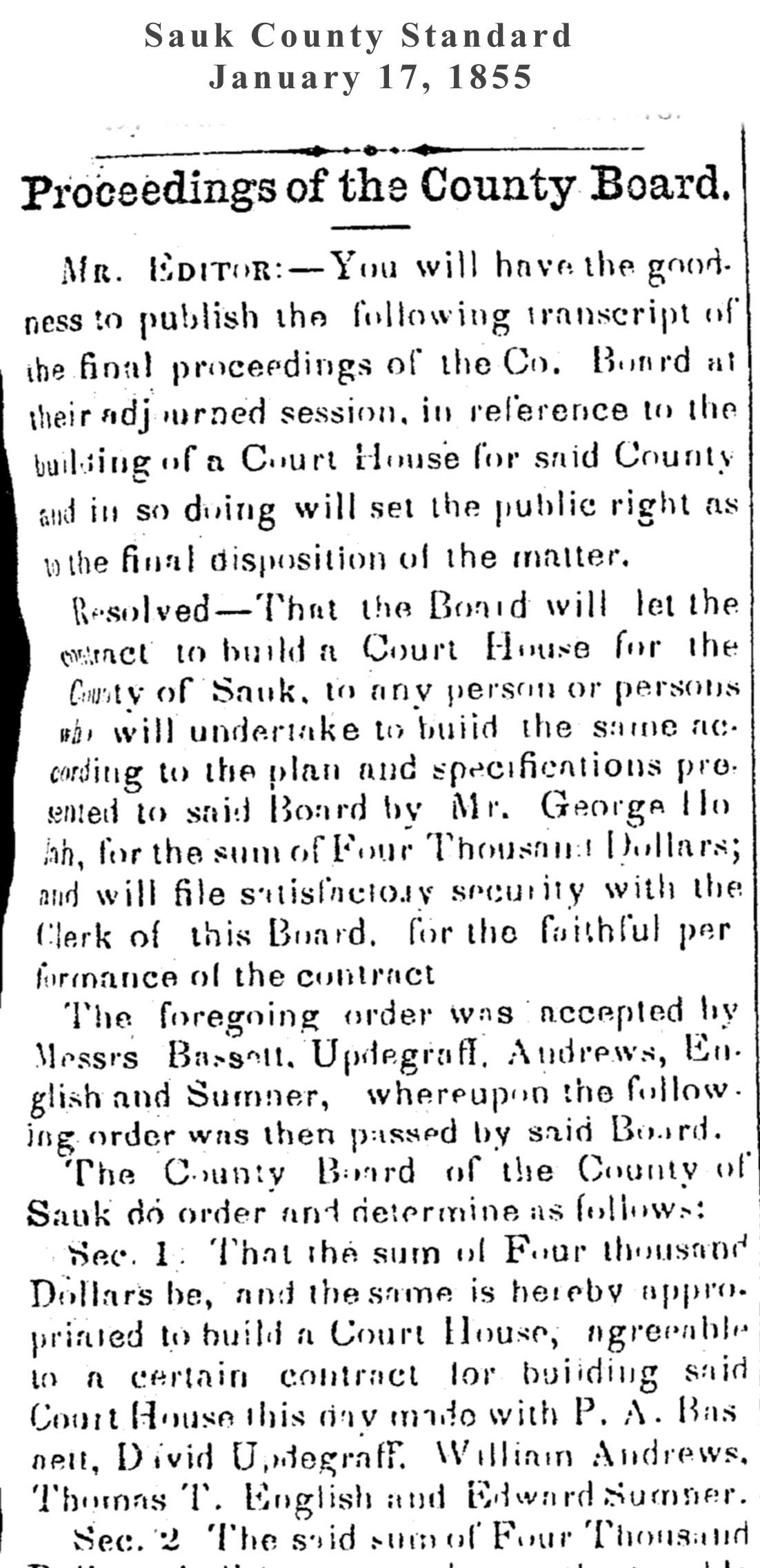




Note the last paragraph, above.
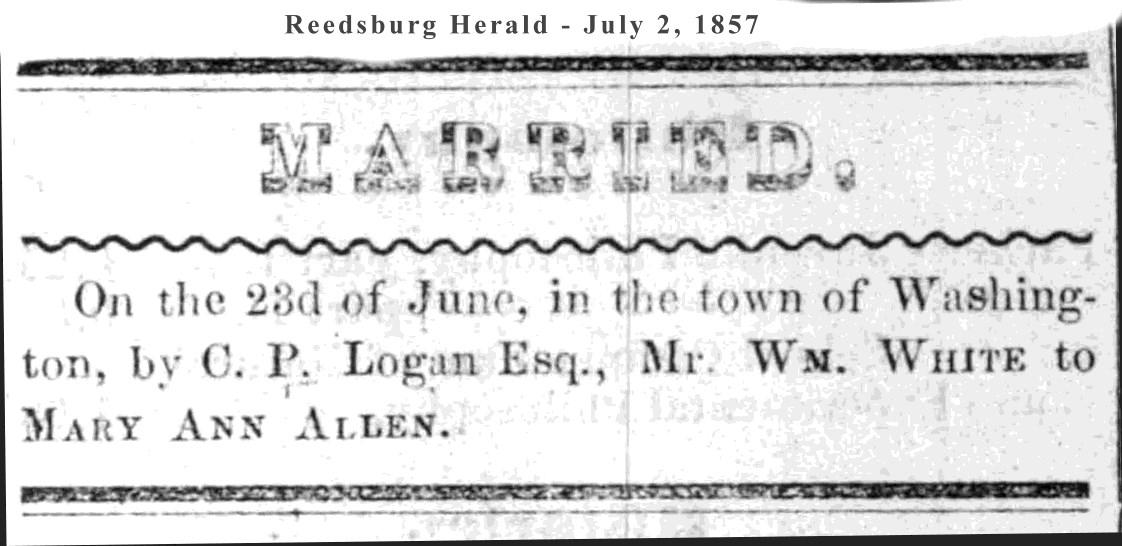

Chauncey Logan was able to perform marriages because he was a Justice of the Peace.

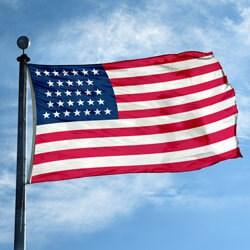


Note the last paragraph, above.

Baraboo News 18 October 1905

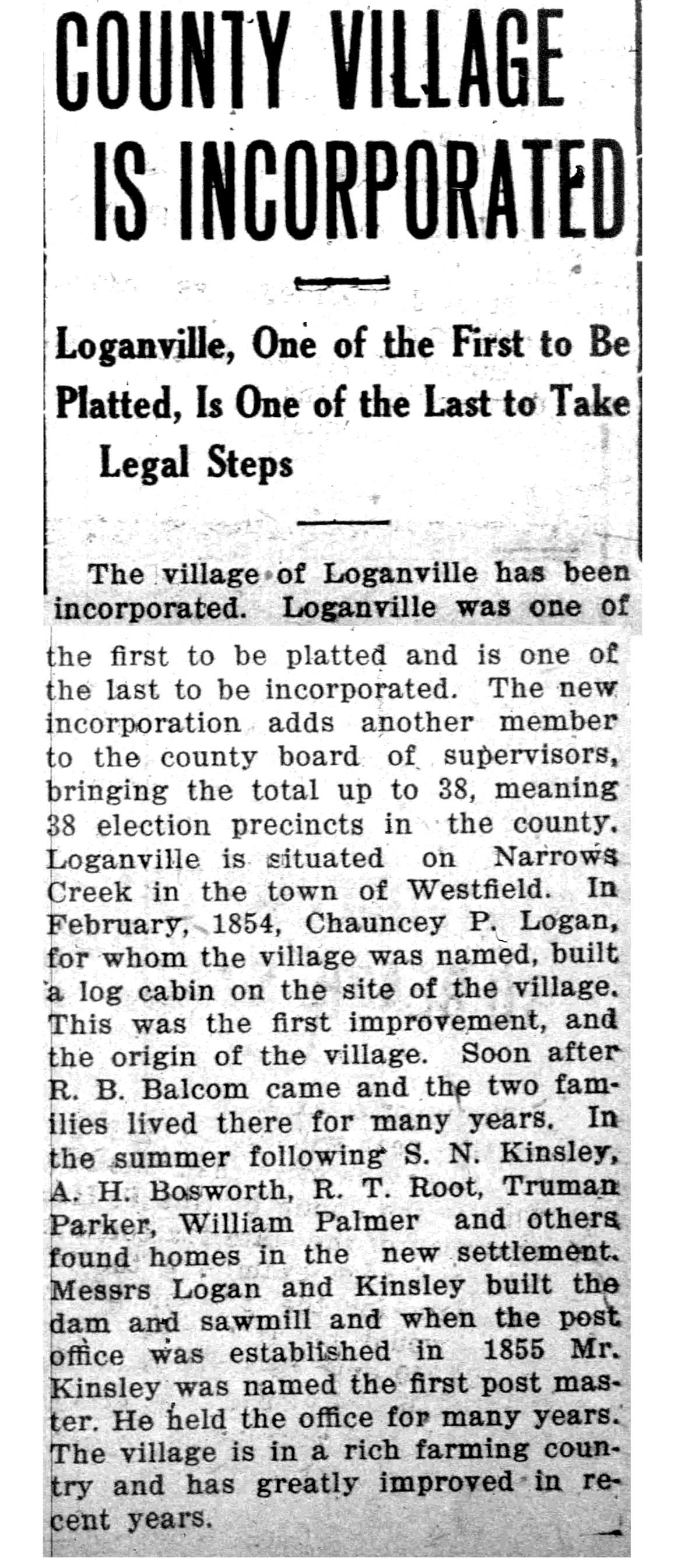
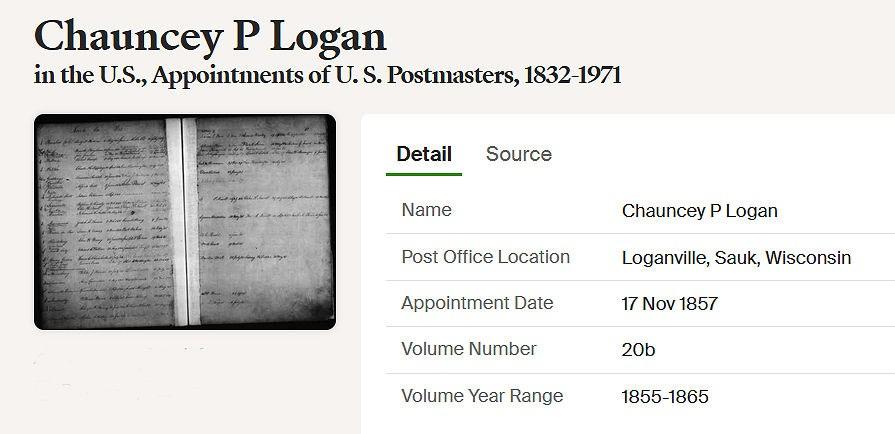


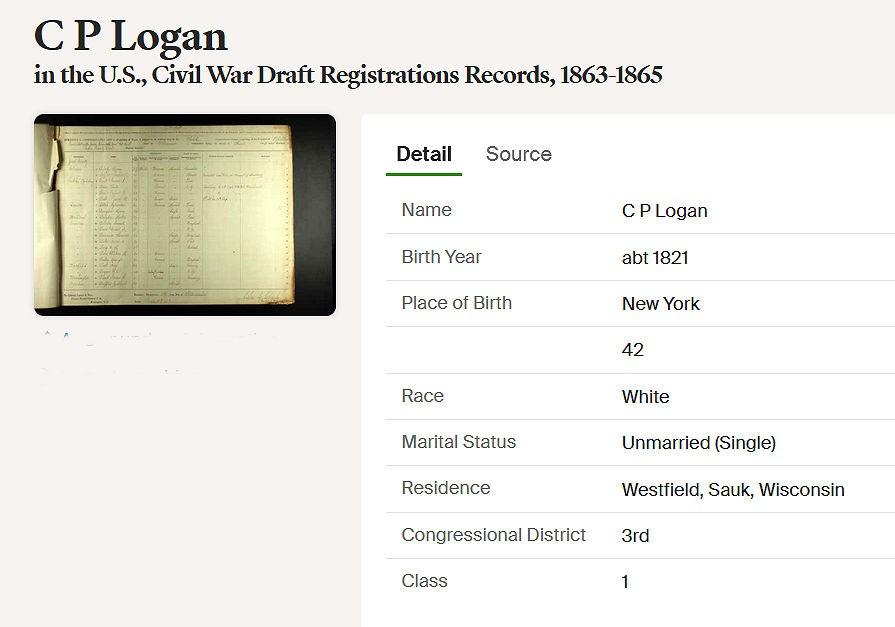

I have found no records which would indicate that he actually served in the Civil War, however every male between 20 and 45 was required to register.
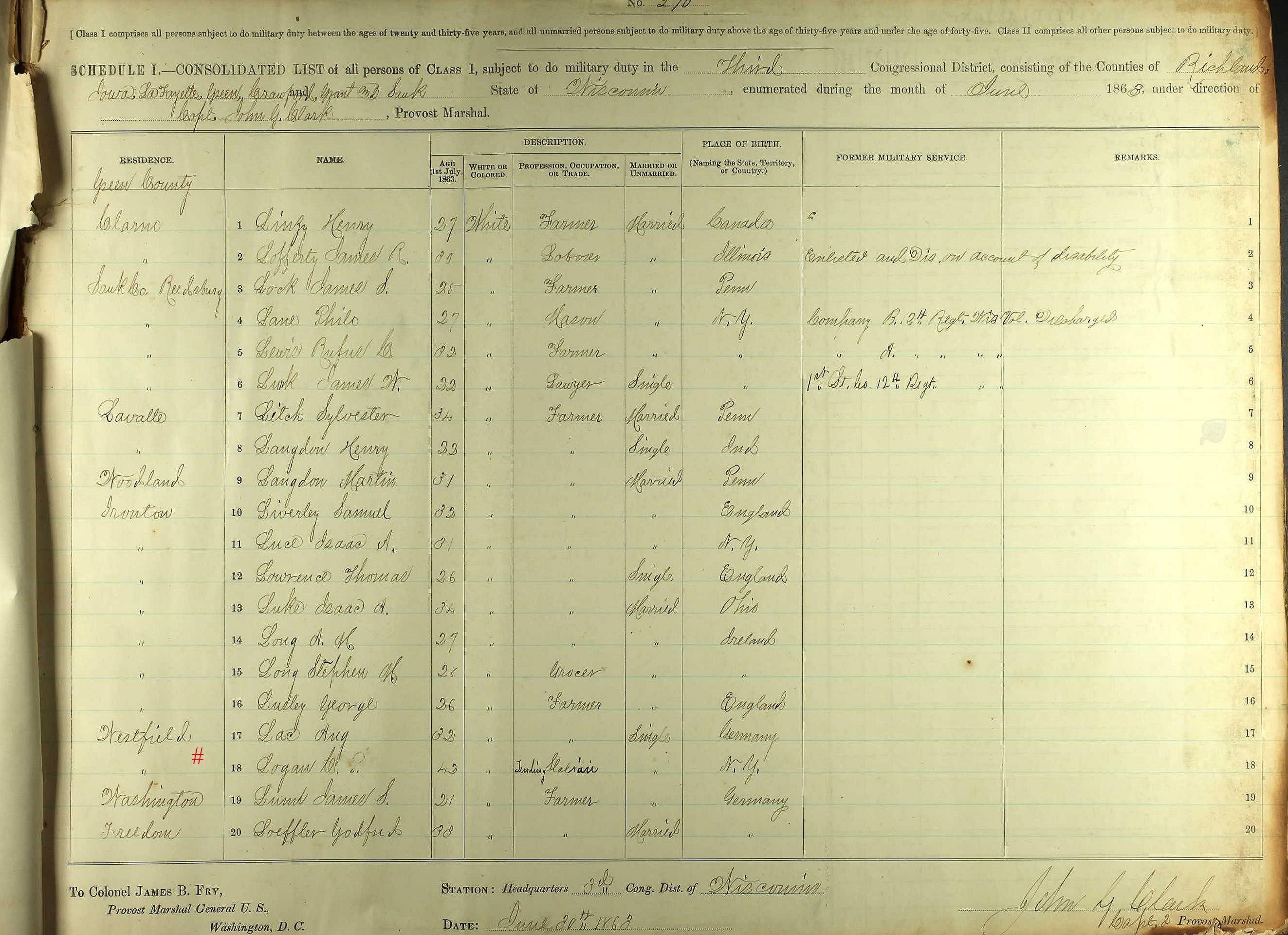

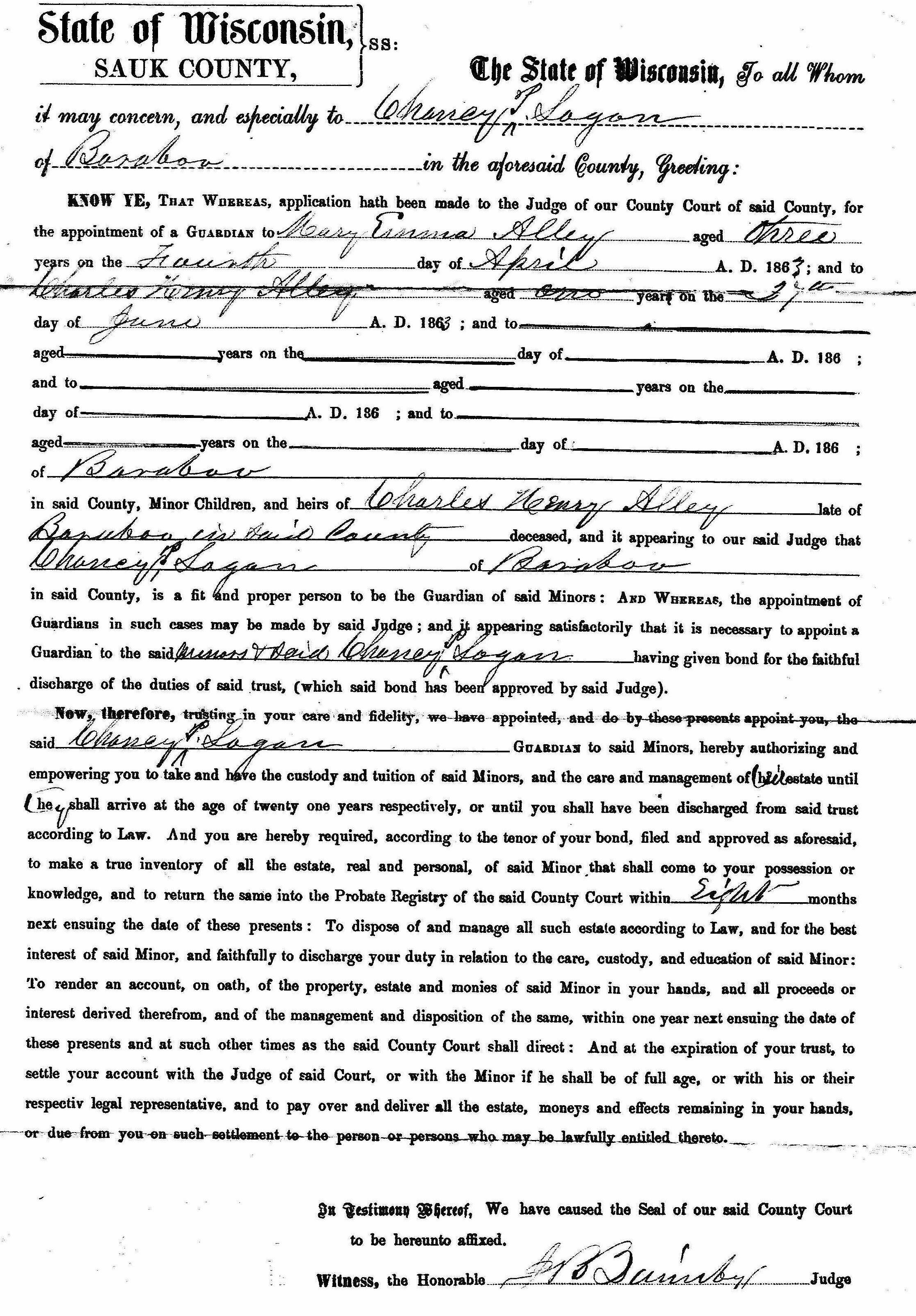
On April 4, 1883, Chauncey Logan was awarded the guardianship of three year old Mary Emma Alley. She was the daughter of Catherine A. Shourds Alley and Charles Henry Alley. Charles had died in the Civil War. On July 8, 1863, Catherine A. Shourds and Chauncey P. Logan were married.


Marriage record of Charles Alley and Catherine Shourds. After the death of Charles, she married Chauncey Logan. The children of both marriages are listed below on the document..
The following three pages contain the 2017 research of

# Note: There is no record of Chauncey joining the Army during the Civil War, as stated above. Only that he registered for the draft.


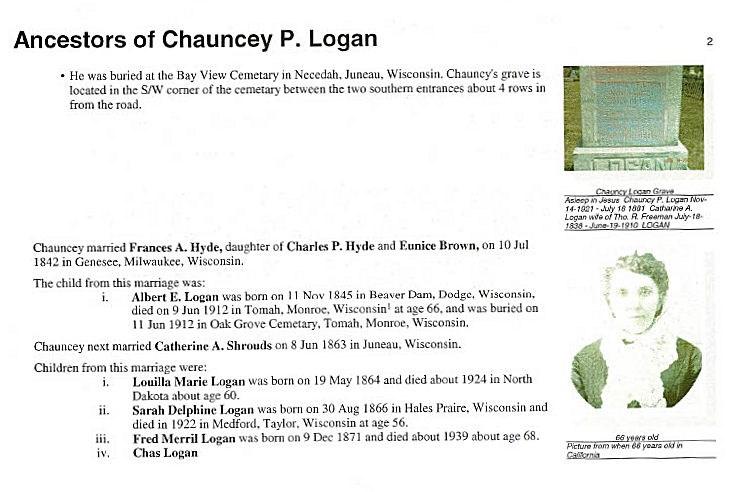








I took a small canister of dirt from Loganville and sprinkled it onto Logan’s grave. I then took a small canister of dirt from Logan’s grave, and sprinkled it around the village of Loganville.
